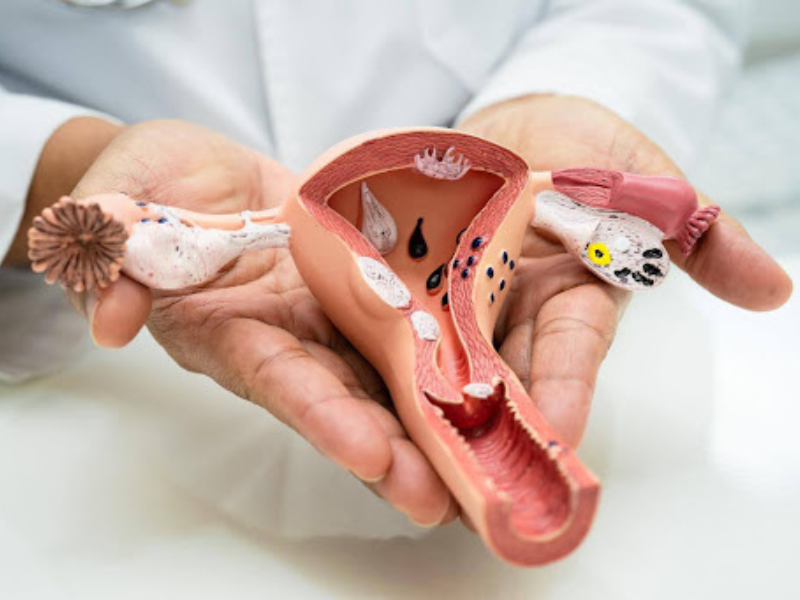
Understanding Endometrial Thickness: A Guide for Women
Menopause marks a significant transition in women’s lives with the invitation of various seen and unseen annoying changes be it physical, mental, or psychological. Among them, changes in endometrial thickness stand tall for consideration as it undergoes severe alterations during menopause and all credit goes to the declined hormones. Talking about endometrial thickness is important in reproductively viable women; however, understanding it after menopause is essential for identifying potential health risks, including endometrial hyperplasia.
What is Endometrium?
The endometrium is the innermost layer of the uterus, which keeps on changing throughout a woman’s menstrual cycle and plays a crucial role in making a woman fertile. Biologically, it consists of two layers: a functional layer which sheds every month during menstruation, and a basal layer which remains intact and helps regenerate the functional layer for the next cycle.
Here comes the role of estrogen and progesterone in governing this process; estrogen promotes endometrial thickening during the first half of the menstrual cycle (follicular or proliferative phase), while progesterone stabilizes and prepares it for a possible pregnancy in the second half (luteal or secretory phase). If pregnancy occurs, it keeps on thickening and more vascular whereas if the pregnancy does not occur, the endometrial lining is shed, leading to menstruation.
Endometrial Transition Before and After Menopause
During reproductive years, the endometrial thickness fluctuates throughout the menstrual cycle. From the early proliferative phase to the end of the luteal phase, the thickness varies from 5-16 mm however, with the onset of menopause, the declined ovarian hormones no longer stimulate the endometrium to grow, and hence, its thickness is drastically reduced.
In post-menopausal women, endometrial thickness typically decreases to around 4-5 mm. Despite this natural thinning, changes in endometrial thickness post-menopause must be carefully monitored, as abnormal thickening (beyond 4-5 mm) can indicate underlying health issues.
What Are The Potential Causes of Endometrial Thickness After Menopause?
Understanding and awareness about the cause of endometrial thickness after menopause is key to maintaining uterine health. While some causes are benign, others may indicate more serious conditions.
Here are some of the common causes of abnormal endometrial thickening after menopause:
1. Endometrial Polyps
These are benign growths that develop inside or outside of the uterine lining. While they are mostly non-cancerous, their growth may cause thickening of the endometrium and abnormal bleeding in post-menopausal women.
Sometimes they are surgically removed when they are larger and produce niggling symptoms. Endometrial polyps are most commonly occurring in the perimenopause phase due to massive hormonal imbalances.
2. Endometrial Hyperplasia
Due to normal or abnormal stimuli, when endometrial cells start growing more rapidly than unusual and causing them to enlarge, it is called hypertrophied endometrium. Generally, it happens due to hormonal fluctuation, with too much estrogen and insufficient progesterone for stimulating the endometrial lining to grow.
Women experiencing perimenopause are at higher risk and therefore, consult the health care provider as and when they feel, without any ifs and buts.
3. Obesity
Due to severe hormonal imbalance at menopause, women often get imbalanced weight which leads to obesity and it is one of the major factors for endometrial thickening. Due to excessive weight gain, women are also prone to endometrial hyperplasia which ultimately develops into cancer if left untreated.

4. Hormonal Replacement Therapy (HRT)
Some women opt for HRT to overcome menopausal symptoms like hot flushes, mood swings, night sweats, vaginal dryness, and so forth however, it does not suit every woman.
If a woman is at estrogen-only HRT, progesterone deficiency in the uterus may lead to the overgrowth of the uterine lining (endometrium) and therefore increase the risk of endometrial hyperplasia.
Focus on Endometrial Hyperplasia in Menopause
As discussed, it occurs when there is an imbalance between estrogen and progesterone, leading to excessive growth of the endometrium. Hyperplasia of the endometrium is more likely to occur in menopausal women who are either obese or running on HRT.
There are different types of endometrial hyperplasia, ranging from simple to complex with or without abnormal cells. In the case of complex hyperplasia and abnormal cell growth, the risk of progression to endometrial cancer increases.
Observe the Symptoms of Endometrial Hyperplasia
Menopausal women should critically observe the symptoms if they suspect any abnormality related to uterine health. The most common symptom is abnormal uterine bleeding, which can take several forms in menopausal women like:
- Spotting or light bleeding,
- Heavy or prolonged bleeding and
- Unusual discharge.
- Pelvic pain and pressure
Any of these abnormal episodes must be reported and discussed with healthcare providers. While not all cases of post-menopausal bleeding are caused by serious conditions, the possibility of hyperplasia or cancer necessitates prompt evaluation.
Measuring Endometrial Thickness
The most common and non-invasive method for assessing endometrial thickness in postmenopausal women is transvaginal ultrasound. It is an imaging technique that allows healthcare providers to measure the thickness of the endometrial lining and evaluate its structure. In menopausal women, an endometrial thickness greater than 5 mm typically warrants further investigation.
If the ultrasound shows a thicker-than-normal endometrium, an endometrial biopsy is performed. In this procedure, medical experts take a small sample of endometrial tissue and then analyze it for any abnormal or precancerous cells.
Ignoring the Abnormal Endometrial Thickness??
Any symptoms associated with uterine health at menopausal age must be taken critically because ignoring them can lead to serious health consequences. Progression of endometrial hyperplasia to endometrial cancer is amongst the most concerning risks.
Women with risk factors such as prolonged estrogen exposure, obesity, diabetes, and hypertension are at even higher risk of developing endometrial cancer. Regular monitoring and early detection are crucial in managing these risks and ensuring better health outcomes.
Treatment Regimen For Managing Endometrial Thickness
The treatment for endometrial hyperplasia or abnormal endometrial thickness depends on the severity of the condition and whether atypical cells are present. For simple hyperplasia without abnormal cells, the available treatment options include:
- Progestin Therapy: Progestin is a synthetic form of progesterone that can be administered to balance the effects of estrogen and reduce endometrial thickness. It is available in the form of oral dosage, injections, or through an intrauterine device.
- HRT Adjustment: If a woman is on estrogen-only HRT and has endometrial thickness, adding progesterone or switching to a combined HRT can help prevent further thickening of the uterine lining.
- Surgery: In severe cases of endometrial thickness, a hysterectomy (surgical removal of the uterus) may be recommended. This procedure eliminates the risk of progression to cancer.
Dos and Don’ts for Preventing Endometrial Thickness
Preventing abnormal endometrial thickness after menopause involves a combination of lifestyle modifications and regular medical check-ups.
- Regular Check-ups: Menopausal women, especially those on HRT or with other risk factors, should have regular gynecological exams and transvaginal ultrasounds to monitor their endometrial health.
- Daily Exercise: Excess fat tissues produce androgens (estrogen), so, keeping a healthy weight by doing daily exercises can reduce the risk of abnormal endometrial thickening and related conditions.
- Balanced Diet: A diet including plenty of fruits, vegetables, and whole grains can help manage body weight and hormone levels.
- Ignorance of the Symptoms: Post-menopausal bleeding or spotting, even if it seems minor, should never be ignored because it is one of the most common indications of abnormal endometrial changes.
- Quit Smoking: Smoking influences estrogen metabolism and increases the risk of various cancers, including endometrial cancer.
- Medical Supplements and Alternatives: Never do self-help on the verge of your health. Taking alternative treatments including herbal supplements without any medical guidance is not a good practice.
Final Takeaway
Endometrial thickness after menopause is a vital signal of uterine health, and monitoring changes in the thickness of the endometrium can help early detection of potential health issues. The abnormal endometrial thickness during menopause, especially when associated with bleeding, should never be ignored as it may lead to serious complications including cancer.
By staying vigilant about endometrial health, maintaining a healthy lifestyle, and undergoing regular medical check-ups, women can ensure the navigation through menopause with confidence and minimize the risk of developing serious conditions related to endometrium.
Citations
- https://www.medicalnewstoday.com/articles/327036
- https://obgyn.onlinelibrary.wiley.com/doi/full/10.1002/uog.1704
- https://www.jogc.com/article/S1701-2163(24)00414-6/abstract#:~:text=In%20a%20postmenopausal%20woman%20several,than%204%E2%80%935%20mm%20thick
- https://www.volusonclub.net/empowered-womens-health/measuring-endometrial-thickness-in-postmenopausal-women/

Poonam Rawat







